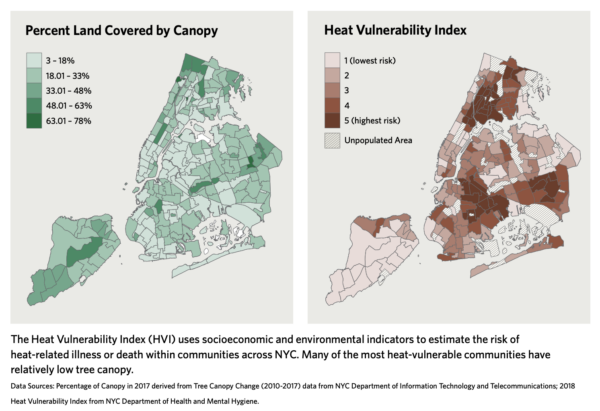In a move applauded by environmentalists and sustainability advocates, the New York City Council passed Int. 1065 on Thursday, a groundbreaking bill aimed at expanding the city’s tree canopy cover from its current 22% to an ambitious 30%.
The legislation, officially titled “An Urban Forest Plan,” not only sets forth an ambitious goal for increasing tree canopy coverage but also mandates the creation of a comprehensive urban forest master plan. This master plan, to be submitted to the City Council by July 31, 2024, will play a pivotal role in identifying the causes of urban forest loss and establishing concrete goals to both expand and safeguard New York City’s vital urban forest.
The term “urban forest” encompasses all trees and shade-producing vegetation within the city, including those not under the direct ownership or jurisdiction of the commissioner, as outlined in the bill.
The 7 million trees in New York City’s urban forest, however, are held on both private and public land. Governed by multiple agencies, including the Department of Environmental Protection, New York City Housing Authority, Department of Parks and Recreation, and the Department of Transit, among others — Int. 1065 seeks to unify these disparate groups under one comprehensive master plan.
A spokesperson for the Department of Parks underscored the importance of this legislation, stating, “As the City deals with the effects of climate change and severe weather, it’s more important than ever to grow our urban forest to absorb stormwater, help clean our air, and provide essential shade for our neighborhoods.”
The New York City Environmental Justice Alliance (NYC-EJA), a prominent advocacy group, played a pivotal role in advocating for the passage of Int. 1065. They stressed the significance of equitable distribution of the tree canopy, emphasizing that neighborhoods with more trees and parks experience a range of downstream benefits.
According to a city arborist with the NYC Parks Department, “Urban forests provide a vast swath of benefits like reducing heat island effect, pollution, improve mental health, provide valuable habitat.”
The heat island effect, an urban phenomenon where built environments absorb and re-emit the sun’s heat, results in urban areas experiencing higher daytime temperatures than natural landscapes. According to the EPA, this can result in urban heat islands experiencing daytime temperatures 1–7°F higher than if the area was a natural landscape. Vulnerable communities, often located in areas with fewer trees, bear the brunt of this phenomenon.
NYC-EJA expressed their support for Int. 1065, stating, “It’s been a really important piece of legislation for us because we want to make sure that we are centering equity when we’re talking about the expansion of the urban forest. We want to ensure that neighbors who haven’t been prioritized are given the attention they deserve, focusing on the communities that need this infrastructure the most.”

Int. 1065 was submitted to the council along with Int. 1066 in June by the NYC Urban Forest Task Force coalition (now renamed Forest For All NYC). Int. 1066, the first of the two bills to be passed, amends Local Law 84 from 2013, establishing a charter for long-term sustainability and resiliency planning. It explicitly includes “the role of trees, tree canopy, and vegetation” in the implementation of sustainability and resiliency programs or policies. Together, these two pieces of legislation position trees at the forefront of New York City’s fight against climate change, marking a significant step toward a more sustainable and resilient future.
Forest for All NYC, a coalition that advocated for these two bills, also released the Urban Forest Agenda, a document containing research and strategies that could help form the master urban forest plan. The Agenda, written with the input of over 40 groups, outlines a plan to achieve 30% canopy coverage, management strategies to maintain the forest, as well as research on the importance of the urban forest.
To celebrate New York’s wonderful urban forest, October 14 is City of Forest Day. Here’s how you can celebrate. Or, learn how to care for the “Lungs of New York” by becoming a citizen pruner, or a tree steward.
This post first appeared on brooklyneagle.com.



Hi ,
This is the first time I read your news letter. I am in favor of taking care of the environment. However, it is wonderful that legislation was past for more trees but what good is it if the trees are not maintained. I live on a tree lined block in Brooklyn and every time a storm happens long tree branches fall. Many people, who are residents, called the city but nothing has been done in years.My concern is for people’s safety as while as their property. What can we do ? Thank you for letting me vent. ❤️